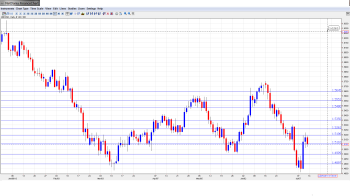The pound finally broke out with a strong week, as GBP/USD climbed 140 points. The pair closed just above the 1.5000 line. This week’s key events include CPI, Claimant Count Change, and Retail Sales. Here is an outlook of the events and an updated technical analysis for GBP/USD.
The pound had a strong week, posting gains against the dollar. However, this rise was due to the broad weakness of the dollar rather than strength in the pound. The British currency jumped on the bandwagon as the US Federal Reserve cooled down expectations of QE tapering, sending the greenback lower against the major currencies.
Updates:
- GBP/USD started the week with a slide, as the dollar showed strength across the board. However, a weak retail sales number from the US helped cable escape the 1.50 line.
- Opinion: Selling England by the pound – GBP/USD on the defensive
- Technical analysis: GBPJPY: Continues To Consolidate.
- British inflation falls short of expectations, with 2.9%. GBP/USD slides towards 1.5050.
- GBP/USD leaps on a combination of excellent jobless drops and a hawkish MPC meeting minutes. Cable leaped above 1.52. The unemployment rate remained unchanged at 7.8%.
- Average Earnings Index jumped climbed from 1.3% to 1.7%.
- Weak housing data in the US and the lack of news from Bernanke in the prepared testimony pushed the dollar a bit lower.
- Opinion: Sterling’s post minutes surge – a sell opportunity
- And: see how to trade the UK retail sales with GBP/USD.
- Retail Sales posted a small gain of 0.2%, matching the estimate. The key indicator looked much sharper last month, jumping 2.1%.
- Public Sector Net Borrowing will be released on Friday.
- GBP/USD is testing the 1.52 line.
- UK PSNB came out at 10.2 billion, above expectations, and this is a disappointment. Nevertheless, GBP/USD is holding up.
GBP/USD graph with support and resistance lines on it. Click to enlarge:
- Rightmove HPI: Sunday, 23:01. This housing inflation indicator provides a snapshot of activity in the UK housing sector. The June release dropped to 1.2%, the smallest gain in 2013. The markets will be looking for some improvement in the July reading.
- CPI: Tuesday, 8:30. There are a string of inflation releases on Tuesday, highlighted by CPI. The index has been fairly steady in 2013, and the markets estimates have been accurate. The markets are anticipating a jump to 3.0% in the upcoming release, which would be the sharpest gain in over a year.
- PPI Input: Tuesday, 8:30. PPI Input looks at the change in prices incurred by British manufacturers for the purchase of goods and raw materials. The index has posted three consecutive declines, pointing to weak activity in the UK manufacturing sector. Another drop is expected in the July release, with an estimate of -0.1%.
- RPI: Tuesday, 8:30. The Retail Price Index is similar to CPI, but includes housing costs, which CPI does not. The index has been fairly steady, and market estimates have been accurate. The estimate for the July release stands at 3.4%, which would be the sharpest gain since May 2012.
- BOE Executive Director Paul Fisher Speaks: Tuesday, 10:30. Fisher will speak about QE at a hearing of the Treasury Select Committee in London. Remarks which are considered more hawkish than expected could push up the pound.
- Claimant Count Change: Wednesday, 8:30. This is a key indicator, and can affect the movement of GBP/USD. The indicator has come in below the estimate for four consecutive months, and the markets are expecting another solid showing in July, with an estimate of -7.9 thousand. The Unemployment Rate, which has been at 7.8% for the past two months, is expected to remain unchanged.
- MPC Asset Purchase Facility Votes: Wednesday, 8:30. This release details the breakdown of the MPC vote on the last Asset Purchase Facility decision. The past several decisions had a 6-3 majority, but the markets are expecting a 7-2 breakdown at the last vote. There could be added drama since this past vote was the first under the helm of new BOE governor Mark Carney.
- MPC Official Bank Rate Votes: Wednesday, 8:30. The markets are expecting the breakdown on this vote to be a unanimous 9-0 decision, which has been the case for every vote since August 2011.
- Average Earnings Index: Wednesday, 8:30. This consumer inflation indicator measures the amount of inflation in labor costs incurred by businesses and government. The index rose sharply to 1.3% last month, and the markets are expecting another rise of 1.4%, which would equal the sharpest gain registered in 2013.
- Retail Sales: Thursday, 8:30. After a sharp decline in the May release, Retail Sales bounced back last month, climbing 2.1%, easily beating the estimate of 0.8%. This matched its best performance of 2013. The markets are bracing for a much smaller gain this time around, with an estimate of 04%. Will the indicator again surprise the markets with and beat the prediction?
- Public Sector Net Borrowing: Friday, 8:30. The government has posted budget deficits since January, so overspending continues to be a serious problem. The deficit grew to 10.5 billion pounds in the June reading, but this was below the estimate of 12.7 billion. The markets are expecting a better result in the July release, with an estimate of 9.4 billion pounds.
Live chart of GBP/USD: [do action=”tradingviews” pair=”GBPUSD” interval=”60″/]
GBP/USD Technical Analysis
It was a busy week for the pair. GBP/USD opened the week at 1.4859. The pair dropped to a low of 1.4813, as the support line of 1.4781 remained firm (discussed last week). GBP/USD but roared back with sharp gains, climbing to a high of 1.5221. The pair then lost some ground, and closed the week at 1.5101.
Technical lines from top to bottom:
With the pound racking up some gains, we start at higher ground.
There is strong resistance at 1.5648. This line has held firm since mid-June, when the pound began a sharp downturn which saw it drop below the 1.49 line. 1.5550 is the next resistance line.
1.5484 saw some action in mid-June, and strengthened as GBP moved sharply lower.
1.5350 was a key resistance line in April, and has remained in place since mid-June. This is followed by 1.5258, which reverted to a resistance role after providing support since late May.
The line of 1.5196 follows. It was breached as the pound surged higher, but remained in place at the end of the week.
Next is 1.5110. This line is providing weak resistance, and could be tested early next week.
1.5000 is a critical level. It was providing resistance last week, but has reverted to a support role. This is followed by support at 1.4897, which has seen activity in July, as the dollar moved higher.
1.4781 face some pressure as the pair dropped close to the 1.48 level early in the week. This line has remained intact since June 2010.
This is followed by 1.4529, which has strengthened as the pair trades at higher levels.
We wrap up with support at 1.4346. This line saw a fair bit of action in the first quarter of 2009, and was last tested in June 2010.
I remain bearish on GBP/USD.
The pound had a strong week, taking advantage of a broadly weaker US dollar. However, we’ve seen the greenback rebound quickly in the past and with most US numbers looking solid, the dollar could bounce back. There are some key British releases this week, and if these disappoint, the pound could take a hit.
Further reading:
- For a broad view of all the week’s major events worldwide, read the USD outlook.
- For EUR/USD, check out the Euro to Dollar forecast.
- For the Japanese yen, read the USD/JPY forecast.
- For the Australian dollar (Aussie), check out the AUD to USD forecast.
- For USD/CAD (loonie), check out the Canadian dollar forecast.

